At the valedictory address of the Aadi Thiruvathirai festival held at Gangaikonda Cholapuram, Prime Minister Narendra Modi highlighted the legacy of Rajendra Chola I and his father Rajaraja Chola I.
- The festival was also organised to commemorate 1,000 years of the maritime expedition of Rajendra Chola to south-east Asia as well as the construction of the iconic Gangaikonda Cholapuram temple, a World Heritage Site.
About the Cholas
- The Chola Dynasty was a prominent Tamil Empire that flourished between the 9th and 13th centuries.
- Key figures like Rajaraja Chola I (985-1014 AD) and Rajendra Chola I (1014-1044 AD) established a powerful empire.
- The Cholas demonstrated that India was not merely a mainland power but also a formidable marine power, extending their influence and control over lands as far as Indonesia.
- Their initial capital was Thiru, which later shifted to Gangaikonda Cholapuram, literally meaning ‘the city of the Chola who conquered the Ganga’.
- The empire notably focused on Tamil culture, exceptional architecture, and dominated the trade routes of Southeast Asia.
Lessons for Modern India
- Strategic Naval Prowess: Rajendra Chola I’s naval expedition around 1025 AD into Southeast Asia is a testament to their strategic foresight.
- He launched an attack on the Sri Vijaya Empire in Indonesia, effectively dominating and securing crucial trade routes across Southeast Asia.
- This expansion spread India’s reputation and influence across the seas, demonstrating a powerful blend of military strength and economic ambition.
- Architectural Excellence: Chola temples like the Brihadisvara and Gangaikonda Cholapuram have withstood the test of time and natural disasters due to advanced architectural design. This stands in stark contrast to modern infrastructure that often crumbles prematurely.
- Their construction ingeniously involved interlocking granite blocks without the use of cement, showcasing advanced engineering knowledge.
- Advanced Water Management: The Cholas built sophisticated irrigation systems, tanks, and canals, particularly in the Cauvery delta, to ensure year-round water supply.
- Today, India faces severe water management challenges, including floods in the Kaveri Delta and persistent inter-state water disputes between Karnataka and Tamil Nadu, highlighting the need to revisit these historical practices.
- Land Revenue System: Chola administration maintained detailed land records and a systematic tax collection mechanism that supported state-building.
- Local Governance: Chola inscriptions reveal vibrant local self-government. They had well-defined Village Assemblies, known as ‘Sabha’, and Ward Committees, called ‘Ur’.
- More than 30 years have passed since the adoption of the 73rd and 74th Amendments to the Constitution, but a large number of local bodies, even in the major cities, are functioning without elected representatives.
- This decentralised approach fostered grassroots participation and efficient administration.
Conclusion
The Chola legacy is far more than historical data; it is a repository of practical lessons in strategic planning, engineering, and governance.
- By studying the legacy of the Cholas, modern India can forge a path towards sustainable development and national self-confidence, echoing the bold and enterprising spirit of its past.
![]() 29 Jul 2025
29 Jul 2025

